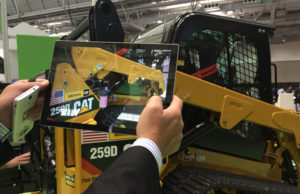I just had to take time out from my live blogging of PTC’s LiveWorx ’18 to focus on one of the topics Jim Heppelmann mentioned in passing in his keynote: the new variation on the company’s Vuforia AR app: Chalk.
Significant in its own right, I suspect Chalk will have an additional, critical impact: democratizing AR.
It is an app aimed at, and accessible to, both corporate audiences AND the general public. Downloadable for both iPhone & iPads & Android devices, I suspect that it will quickly become popular both to support remote repair staff for companies and just plain folks who are trying, for example to help a family member far away to deal with a car or plumbing repair. Not to mention the fact (mandatory disclaimer: while I work part-time for Apple, I’m not privy to any corporate internal strategy) that the spiffy new $329 6th-generation iPad really facilitates AR, and Chalk was developed in conjunction with the Apple ARKit technology so it should really become popular.
Chalk has two components:
- real-time video and voice sharing of the same view
- Chalk Marks, simple handswipes that allow one of the participants to highlight the part that is the subject of the question. The “Marks” appear to be anchored to the subjects they’re “drawn” on.
Real-world uses vary from a remote super-expert helping a field technician to identify and deal with a rare problem to your millennial helping Mom master her personal technology. I saw an amazing demo this morning with one mechanic in Germany (ok, he was actually 2′ away…) directing the mechanic working on a Mercedes how to add coolant. As the press release announcing the app said:
“Today, remote assistance can be frustrating and cumbersome. People struggle for words to describe things that are unfamiliar, whether it be a new appliance or the back of a cable box. And when the problem can’t be described clearly, it becomes almost impossible for someone else to solve. Vuforia Chalk provides a simple and intuitive solution where people can now use Chalk Marks to get a common understanding of a problem, and the steps required to solve it.”
I’ve written before that I suspected many companies got into e-commerce in the 9o’s because a CEO’s kids got him to order a book from Amazon during the holidays & he came back raving about this new device. I can’t help thinking that this will be just the kind of low-cost (heck, in this case, no-cost) introduction to AR And the IoT that will break down some companies’ skepticism, pay off with immediate bottom line benefits in cost savings and efficiency in service operations, and get them interested in most expensive AR such as PTC’s digital twins and predictive maintenance. Or, as ABI analyst Eric Abbruzzes said:
“Mainstream augmented reality is at the beginning of a strong positive inflection point, and Vuforia Chalk is a great example of how AR can transition from enterprise-only to use in everyday life,” said Eric Abbruzzese, ABI Research. “We see Vuforia Chalk as a fundamentally disruptive form of remote communication that will be well received across multiple sectors and for multiple use cases.”
Now to get my granddaughter to download the app so we can collaborate on the 3D-printer that I got her for her 12th- birthday!

